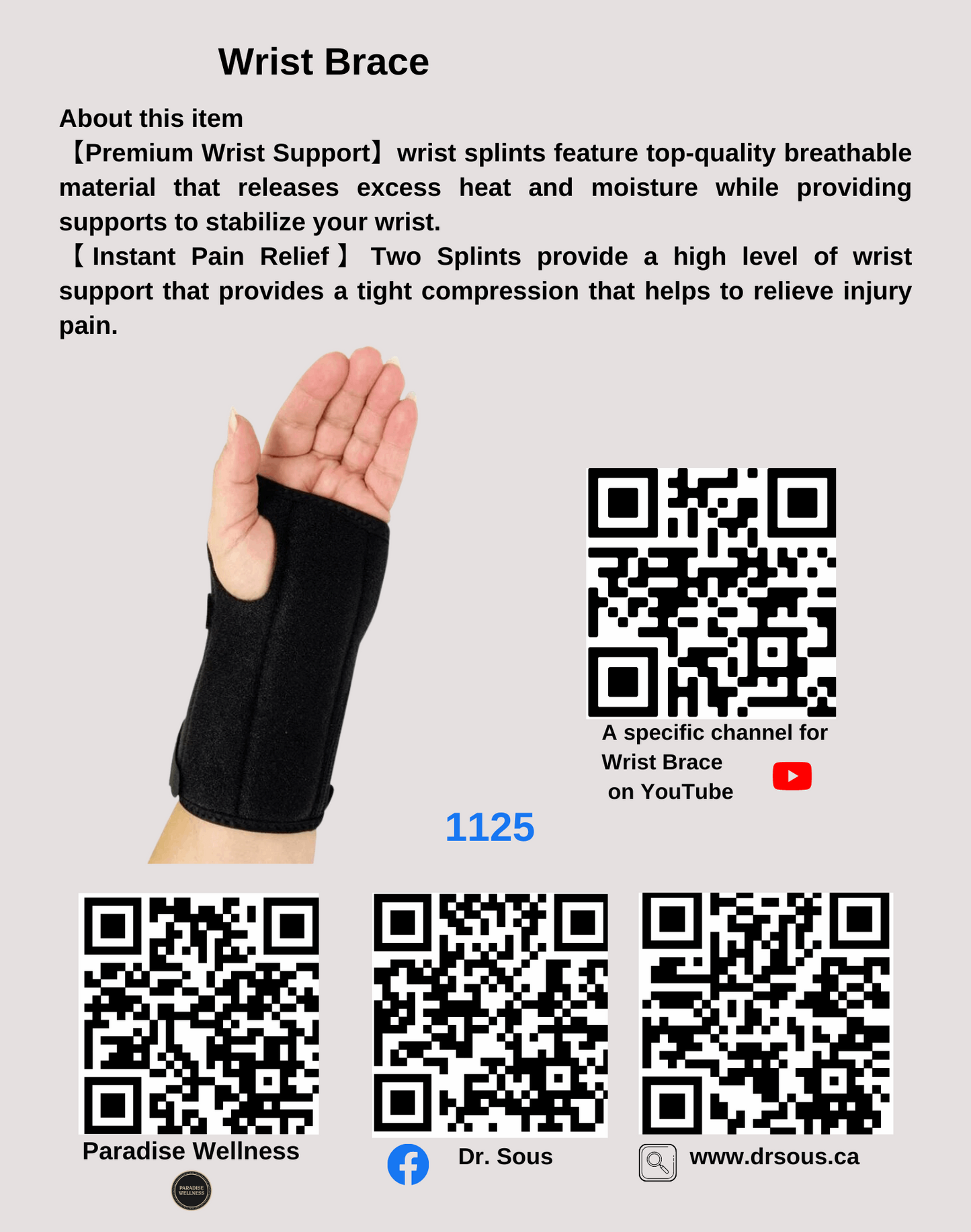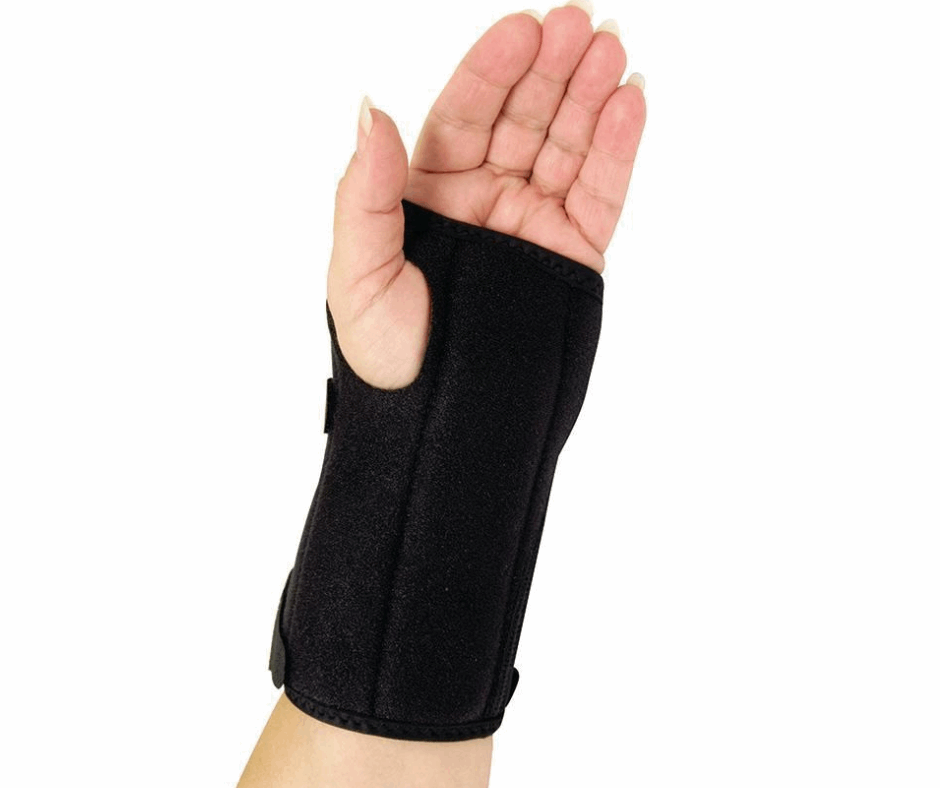1125. Wrist Brace
1125. Wrist Brace
Couldn't load pickup availability
DrSous.Ca
Wrist Brace
|
Size |
L (left 25 and right 25) |
|
Specific uses for product |
Arthritis, Pain Relief |
|
Use for |
Hand |
|
Age range (description) |
Adult |
About this item
【Premium Wrist Support】wrist splints feature top-quality breathable material that releases excess heat and moisture while providing supports to stabilize your wrist.
【Instant Pain Relief】Two Splints provide a high level of wrist support that provides a tight compression that helps to relieve injury pain.
【24-Hours & Multi-Purpose】The wrist brace is comfortable, lightweight, and perfect for multi-purpose use. You can wear them throughout the night, at work, traveling, working out, and more.
【Adjust to Fit Your Need】Our carpal tunnel wrist support features adjustable straps that can be used by all ages, for both men and women.
Research Study
Wrist braces are commonly used to provide support, stability, and protection to the wrist joint. They are designed to help relieve pain, reduce inflammation, and prevent further injury to the wrist. In this article, we will explore the definition and purpose of wrist braces, the different types of wrist braces and their uses, as well as the benefits and drawbacks of wearing a wrist brace. Whether you are an athlete, recovering from an injury, or looking to prevent one, understanding the importance of wrist braces can help you make informed decisions about your health and well-being.
Wrist brace is a medical device that is worn on the wrist to provide support, stability, and protection to the wrist joint. According to Liu et al. (2021), the primary purpose of wrist braces is to prevent or alleviate wrist pain, particularly in individuals who engage in repetitive wrist motions, such as typing or playing sports. Wrist braces are also used to treat a variety of wrist injuries, such as sprains, strains, and fractures. They work by immobilizing the wrist joint, which reduces inflammation and allows the injured tissues to heal. In addition, wrist braces can help improve wrist function and range of motion by limiting excessive wrist movement, which can cause further injury or pain. Another benefit of wrist braces is that they can improve grip strength and reduce the risk of dropping objects, which is particularly important for individuals with weak grip or hand tremors. Overall, wrist braces are an effective and non-invasive treatment option for a variety of wrist conditions and injuries, and can significantly improve wrist function and quality of life for individuals who use them.
Wrist braces are commonly used to provide support and stability to the wrist joint. There are several types of wrist braces available in the market, each designed to address specific wrist-related issues. According to Kelly et al. (2015), wrist braces can be classified into four types: immobilizing, functional, prophylactic, and neoprene. Immobilizing braces are designed to limit the movement of the wrist joint and are commonly used in the treatment of wrist fractures or severe sprains. Functional braces, on the other hand, allow for limited movement of the wrist joint while providing support to the area. These braces are commonly used in the treatment of mild to moderate sprains or strains. Prophylactic braces, also known as preventative braces, are designed to protect the wrist joint from potential injuries during physical activities. These braces are commonly used by athletes or individuals who engage in activities that require repetitive wrist movements. Neoprene braces are made of a synthetic rubber material that provides compression and support to the wrist joint. These braces are commonly used in the treatment of mild to moderate wrist injuries or for individuals who require additional support during physical activities. In conclusion, understanding the different types of wrist braces and their uses can help individuals select the appropriate brace to address their wrist-related issues.
Wrist braces have been utilized for a long time as a form of treatment for wrist injuries or as a preventative measure for athletes engaging in high-impact sports that demand repetitive wrist motions. The benefits of wearing a wrist brace are numerous, including reducing pain and inflammation, stabilizing the wrist joint, and improving overall hand function. A study conducted by Stern et al. (1997) found that patients who wore a wrist brace experienced a significant reduction in pain and an improvement in grip strength. Additionally, wrist braces have been found to be highly effective in preventing further injuries, especially for athletes who have a history of wrist injuries. However, wrist braces also have some drawbacks. One major concern is that the constant use of wrist braces can cause muscle atrophy and reduced range of motion. Another drawback is that wrist braces may not be able to provide adequate support for certain types of injuries, such as fractures. Despite these drawbacks, wrist braces remain an effective and affordable treatment option for those with wrist injuries or those who engage in high-impact sports.
In conclusion, a wrist brace is an essential tool for individuals who suffer from wrist injuries or conditions such as carpal tunnel syndrome. It provides support and stability to the wrist joint, allowing the user to perform daily activities without pain or discomfort. With the advancement of technology, wrist braces are now available in different designs and materials to suit the needs of every individual. It is important to consult with a healthcare professional to determine the appropriate wrist brace for your condition and to ensure proper use. Overall, a wrist brace can significantly improve the quality of life for those who suffer from wrist injuries or conditions.
Work Cited
S Liu., K Tang., J Luo., J Yi."A compact soft robotic wrist brace with origami actuators."https://www.frontiersin.org/articles/10.3389/frobt.2021.614623/full
S Kelly., A Paterson., R Bibb."A review of wrist splint designs for additive manufacture."https://repository.lboro.ac.uk/articles/conference_contribution/A_review_of_wrist_splint_designs_for_additive_manufacture/9340523?utm_medium=email&utm_source=transaction
"Commercial wrist extensor orthoses: a descriptive study of use and preference in patients with rheumatoid arthritis."https://onlinelibrary.wiley.com/doi/abs/10.1002/art.1790100105
Share




